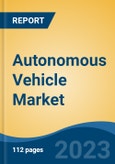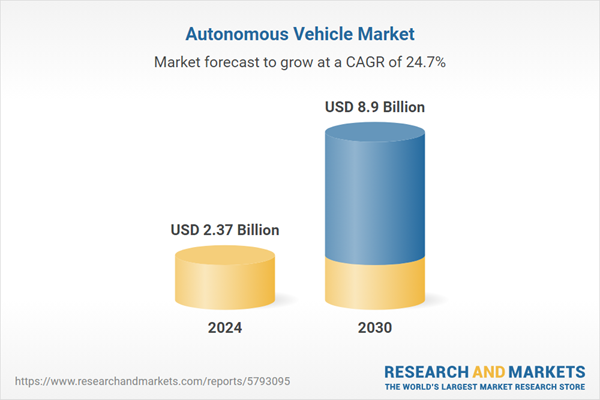Speak directly to the analyst to clarify any post sales queries you may have.
10% Free customizationThis report comes with 10% free customization, enabling you to add data that meets your specific business needs.
The industry is also benefiting from automotive OEMs integrating higher levels of autonomy into mainstream vehicle platforms, shifting autonomous features from luxury to mid-range models. Increasing collaboration between tech firms and automakers is enabling faster prototyping and deployment of Level 3 and Level 4 capabilities. For instance, Level 3 autonomous driving features are set to account for almost 20% of new car sales in Europe by 2025.
Implementing Level 3 autonomy significantly increases vehicle costs and sensor complexity. ADAS average content per vehicle is projected to rise from $533 (Level 2) to $1,046-$2,289 (Level 3), depending on lidar inclusion. Advanced functionality requires more sensors (up to 17 or more), AI software, supercomputing hardware, and high-definition mapping. These cost dynamics are pushing OEMs toward platform collaborations with Tier 1 and Tier 2 suppliers to scale development and reduce time-to-market.
Market Drivers
Growing Popularity of Mobility-as-a-Service (MaaS)
Urbanization and the shift in consumer preferences from ownership to access are fueling the adoption of Mobility-as-a-Service (MaaS), where autonomous vehicles play a central role. Shared autonomous fleets integrated into MaaS platforms offer cost-effective, accessible, and environmentally conscious alternatives to traditional car ownership. This model addresses urban congestion, parking constraints, and last-mile connectivity. Autonomous vehicles enhance the MaaS experience by providing on-demand transport with lower operational costs, minimal human error, and 24/7 availability.Fleet operators and smart city planners are increasingly exploring these models for ride-hailing, shuttle services, and autonomous taxis. The integration of booking apps, real-time vehicle tracking, and seamless digital payments further strengthens the ecosystem. As the business case for AVs in shared mobility improves, cities and companies are launching pilot programs and deploying autonomous pods, buses, and delivery bots. The synergy between AVs and MaaS platforms is creating scalable opportunities for smart urban mobility.
Market Challenges
High Development and Deployment Costs
Developing autonomous vehicles involves significant investment in research, prototyping, hardware integration, software development, and testing. Key components such as LiDAR, high-performance processors, and redundant safety systems are expensive and often custom-designed, driving up the vehicle cost. Extensive simulation and real-world testing are required to validate system performance, demanding further capital and time.Commercial deployment also involves infrastructure upgrades, such as smart traffic signals, HD mapping, and V2X networks, which add to the overall cost. For shared mobility or freight applications, fleet scalability poses logistical and financial challenges. Smaller automakers and tech startups may struggle to meet the financial demands of long product development cycles. Until economies of scale are achieved and component prices drop, affordability will remain a barrier to mass-market adoption. The challenge is further intensified by the uncertain pace of regulation and varying global readiness, making long-term investment recovery unpredictable for industry stakeholders.
Key Market Trends
Integration of V2X Communication for Real-Time Coordination
Vehicle-to-Everything (V2X) communication is becoming integral to autonomous driving by enabling vehicles to interact with infrastructure, other vehicles, and pedestrians. This connectivity allows for real-time data exchange, improving situational awareness and decision-making. V2X supports features like traffic signal priority, hazard warnings, lane merging coordination, and adaptive route planning. As autonomous vehicles operate without human drivers, the ability to "see" beyond their sensors through V2X becomes essential in complex or unpredictable traffic environments.Governments are investing in connected road infrastructure to support V2X capabilities, especially in smart city projects. Automakers and telecom providers are collaborating to integrate 5G and edge computing, reducing latency and enabling faster communication. The trend is also driving the development of cooperative perception systems, where multiple vehicles share sensor data for improved accuracy. Widespread V2X adoption is set to enhance safety, reduce traffic congestion, and accelerate the readiness of urban environments for full autonomy.
Key Market Players
- BMW AG
- Daimler AG
- Ford Motor Company
- General Motors Company
- Hyundai Motor Group
- Pony.AI, Inc.
- Robert Bosch GmbH
- Tesla, Inc.
- Wamyo LLC
- Zoox, Inc.
Report Scope:
In this report, the Global Autonomous Vehicle Market has been segmented into the following categories, in addition to the industry trends which have also been detailed below:Autonomous Vehicle Market, By Mobility:
- Shared
- Personal
Autonomous Vehicle Market, By Vehicle:
- Passenger Car
- Commercial Vehicle
Autonomous Vehicle Market, By Level of Automation:
- Level 1
- Level 2
- Level 3
- Level 4
- Level 5
Autonomous Vehicle Market, By Region:
- North America
- United States
- Canada
- Mexico
- Europe & CIS
- Germany
- France
- U.K.
- Spain
- Italy
- Asia-Pacific
- China
- Japan
- India
- South Korea
- Middle East & Africa
- South Africa
- Saudi Arabia
- UAE
- Turkey
- South America
- Brazil
- Argentina
Competitive Landscape
Company Profiles: Detailed analysis of the major companies present in the Global Autonomous Vehicle Market.Available Customizations:
With the given market data, the publisher offers customizations according to the company’s specific needs. The following customization options are available for the report.Company Information
- Detailed analysis and profiling of additional market players (up to five).
This product will be delivered within 1-3 business days.
Table of Contents
Companies Mentioned
- BMW AG
- Daimler AG
- Ford Motor Company
- General Motors Company
- Hyundai Motor Group
- Pony.AI, Inc.
- Robert Bosch GmbH
- Tesla, Inc.
- Wamyo LLC
- Zoox, Inc.
Table Information
| Report Attribute | Details |
|---|---|
| No. of Pages | 188 |
| Published | September 2025 |
| Forecast Period | 2024 - 2030 |
| Estimated Market Value ( USD | $ 2.37 Billion |
| Forecasted Market Value ( USD | $ 8.9 Billion |
| Compound Annual Growth Rate | 24.6% |
| Regions Covered | Global |
| No. of Companies Mentioned | 10 |









